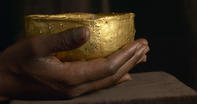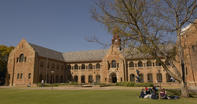Displays and More
The Mapungubwe museum plays a fundamental role in preserving the history of the iconic heritage site. Part of the museum’s mission is to conserve the collection of artifacts for future generations. The museum is working with South African Institute of Objects to establish a metallics department so that it can develop a local capacity for restoration.

Sian Tiley, the curator of the Mapungubwe Museum, pointed out that the museum does more than just display objects in glass boxes. "It has all the functions of a museum: research, conservation, education and so on. It is also the largest service provider for all things Mapungubwian; supplying documents, photographs and facilities to interested parties."
A Partnership is Formed
Sian explains the museum’s relationship with SAN parks: “SAN Parks manages the Mapungubwe Cultural Landscape, including the natural landscape. The university is officially recognised as the manager and custodian of the Mapungubwe Collection. And that collection is not only necessarily artefacts, but the archive, the information, the history.
And we’ve formed a partnership for managing Mapungubwe as a whole.” “At this stage, until Mapungubwe has a proper curation facility, we are serving as temporary curators. And over the past few years, we have recovered thousands of new artefacts while rehabilitating old excavations. But we haven’t got space in our museum, so we are encouraging that collection, which is actually owned by the Mapungubwe National Park, to go there. Then, one day when they have their own research facility, they can build up their own collection.”
Exhibitions for Everyone
When asked whether the famous gold rhino would eventually be returned to Mapungubwe, Sian replied: “Ideally, the university supports that an iconic object, such as the rhino, go back to its place of origin. But at this stage, we don’t only facilitate the rhino just being here (at the museum). We do most of the temporary exhibitions, because the idea is that Mapungubwe must go all over the country, international exhibitions and so on.
The museum is better equipped than a national park to do that. So there are negotiations. But we’ve been working with SAN parks more than 25 years. We’re very good partners.” Debate over the final resting place of the gold rhino is ongoing. It is a tremendously reverential object, imbued with a variety of meanings by different groups. There was a story circulating of a sangoma who came to visit the museum. As he looked at the rhino, he grew agitated. The ancestors were shouting at him, he said.
They wanted him to take the rhino away. If he didn’t take it, he pleaded, the ancestors were going to curse his family. After some discussion, the curator told him that the rhino belonged to the country and the president was the only one who could help him. With that, the sangoma left the museum and walked off in the direction of the Union Buildings.
Visiting the Mapungubwe Museum

The University of Pretoria main campus is full of surprises. It is an attractive place, laid out in a series of lawns and courtyards, and it houses a number of fine museums. These include the Edoardo Villa Museum (a well-known local sculptor), the Anton van Wouw Collection (another famous sculptor), the Van Tilburg collection (mainly ceramics from Europe and China), the University of Pretoria art collection and, of course, the Mapungubwe Museum.
The grounds of the campus are populated with a number of huge sculptures by Edoardo Villa, and there’s an eclectic mix of architecture, ranging from the Union era with a blend of Afrikaner Modernism, which was popular in the 70s.
The Mapungubwe Museum is housed in the Old Arts Building, a beautiful old sandstone structure with grand staircases and leaded window panes. Appropriately enough, this is the former home of the history department, where Professor Fouché first received news of Mapungubwe from Jerry van Graan.
Highlights of the Collection
Although it has over 20 000 visitors a year, many of them on school tours, the Mapungubwe Museum is small. There is currently only one display room, which contains all the highlights of the collection. In the centre of the room, pride of place is given to the rhino, sceptre and bowl.
Viewing these objects with your own eyes is an essential experience. Despite their small size, the artistry and intricacy of their making is abundant. It’s hard to believe that they are 700 years old. The warm lustre of the gold seems to shrug off the centuries. They are truly national (and international) heritage objects of the first order.
Many other fascinating items from the collection are displayed in cases arranged along the outer walls, and there is a series of text displays and info boards to help you interpret the story of Mapungubwe.
By David Fleminger